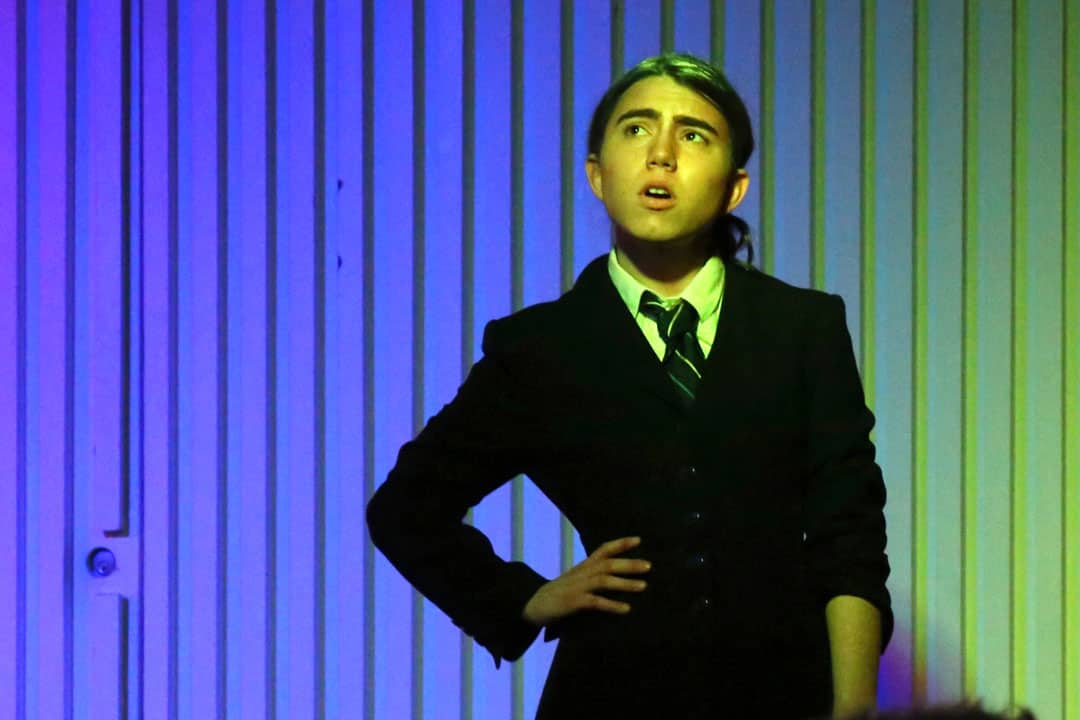Pop songs, lip sync battles, and performances by drag queens and kings lit up The Cat’s Eye Student Pub and Lounge on the evening of Thursday, January 10. Part of the University of Toronto Winterfest’s annual charity drag show, donations went to The 519, a charitable organization that runs a Toronto LGBTQ+ community centre on 519 Church Street.
Wearing a conservative blazer, tie, button-up shirt, and slacks, U of T President Meric Gertler — or at least, his persona interpreted by a drag king — lip-synced to Brittany Spears’ “Circus” as he stripped off his layers of attire to reveal a white tank top, with the word “QUERCUS” emblazed on the front in blue.
“That’s my president!” cheered an audience member in the middle.
The audience was far from passive that night, with lively cheers, hoots, and clapping providing positive reinforcement for the performers, who responded well to the audience’s encouragement.
Juno, a self-described “lesbian drag witch just here to have a good time,” came twice on stage, performing “Potential Breakup Song” by Aly & AJ, and later “Primadonna” by Marina and the Diamonds. She later told me how receiving the audience’s supportive feedback onstage helped ease her tensions to thrive in her persona.
“I definitely was nervous before,” she said. “But, once you get on stage and everybody’s cheering, it’s a very happy, energetic vibe. It gets more comfortable because you realize, even if you do make a mistake, everyone here is just here for a fun time. Nobody’s criticizing you very harshly.”
Another performer, Camila Toe, who was described as a “newcomer to the Toronto drag scene,” was met by cheers for making intricate movements on stage look lithe and effortless. A fourth performer, ZacKey Lime, who was wearing a glitter top with track pants and sporting an exposed midriff, elicited joyous laughter and cheers for creatively incorporating a baby doll with baby powder into a playful performance.
Interspersed between the performances were two lip sync battles between members of the audience who answered a call by lead organizer Jayde Jones, also president of the Victoria University Students’ Administrative Council.
The first battle comprised of two teams of audience volunteers trying to outdo each other in a lip sync dance to a song by Ke$ha. A particularly inspired audience member grabbed two artificial glittery bouquets on the stage and repurposed the props from stage decorations to chest decorations. Laughter and cheers at the creativity won the enterprising audience member a gift bag during the election of the battle’s winner, based on Jones listening to the loud, enthusiastic receptions of the observing audience to each teams.
During the intermission, Jones recommended that I participate in the second battle, citing it as an opportunity for “investigative journalism.” While I have too much respect for investigative journalists to claim this met that high bar, I did join a team onstage upon noticing there was a shortage of volunteers for the second round, in the interest of getting a better perspective on what it is like to perform.
I’m not the best at dancing, but I did vaguely know its general principles. Like how I kind of went along playing basketball in high school gym class by mostly focusing on positioning to compensate for a dearth of ability to handle a ball, I decided to make full use of the stage space, avoid being static, and let the star performers take the lead.
It was a showdown between two teams. Luckily for me, the two lead dancers Thomas Siddall and Trevor Fung, who had also performed in the first lip sync battle, had an excellent duo dancing performance that carried the team.
Afterward, I caught up with Siddall and Fung for an interview. Siddall revealed that this was his first lip sync on stage, though he regularly lip syncs in the morning and at friends’ houses. Fung recalled how he developed his skills by practising in his room for years, getting caught by his siblings.
Fung described how lip syncing can be empowering. It can let performers take on “the confidence of the artist and their whole persona.” Siddall mentioned that being absorbed in the music can make you “forget who you are.”
Siddall described how it can be healthy to feel empowerment in this way. He added that sometimes, being gay “can be a whole mess,” since his mom doesn’t accept his identity, often the case with families of Asian background. He recalled a stranger calling him a slur on public transit for just being on the train, and he also recalled feeling disturbed by the Church-Wellesley killings targeting members of the gay community.
“Honestly, all we want out of this is just for people to be like, ‘Yeah, they’re people too,’” said Siddall. Because, despite the progressiveness of Canadian society, there are still “hurdles” to get over, explained Fung. LGBTQ+ community events like this Thursday evening’s, then, can perhaps help people recognize the humanity of others, regardless of sexual identity.


